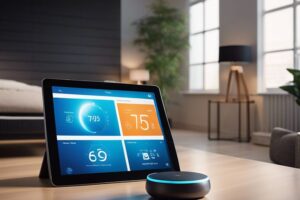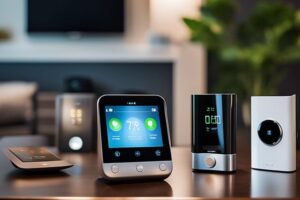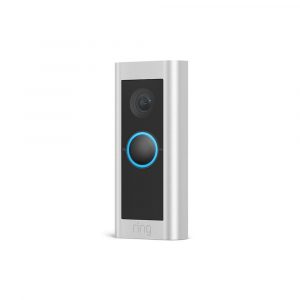Utilising smart home devices for home health monitoring can be a revolutionary way to track and manage your well-being from the comfort of your own home. With the advancements in technology, you can now easily keep track of your vital signs, such as heart rate, blood pressure, and blood glucose levels, with the use of smart devices. By incorporating these devices into your daily routine, you can stay proactive in managing your health and detect any potential issues before they escalate. In this guide, we will walk you through the process of setting up and using smart home devices to monitor your health, helping you take control of your well-being.
Key Takeaways:
- Convenience: Smart home devices offer convenience in home health monitoring by providing real-time data and alerts to both patients and healthcare providers.
- Remote Monitoring: These devices allow for remote monitoring of vital signs and health parameters, enabling healthcare professionals to keep track of their patients’ well-being without the need for in-person visits.
- Early Detection: By continuously monitoring various health metrics, smart home devices can help in the early detection of potential health issues, allowing for proactive intervention and treatment.
- Patient Empowerment: The use of smart home devices in home health monitoring empowers patients to take control of their own health and well-being by providing them with valuable insights and information about their own health status.
- Cost-Effectiveness: With the ability to reduce the number of hospital or clinic visits, smart home devices for home health monitoring can result in cost savings for both patients and healthcare systems.
Selecting the Right Smart Home Health Devices
When it comes to health monitoring using smart home technologies, selecting the right devices is crucial for accurate and reliable data. With a wide range of options available, it’s important to consider various factors before making a purchase.
Factors to Consider Before Purchasing
Before investing in smart home health devices, you should consider the following factors:
- Accuracy: Ensure that the devices provide accurate and precise measurements to monitor your health effectively.
- Compatibility: Check whether the devices are compatible with your existing smart home ecosystem to seamlessly integrate with other devices and applications.
- Data Security: Prioritise devices that offer robust data security measures to protect your sensitive health information.
After considering these factors, you can make an informed decision about which smart home health devices are best suited for your needs.
Tips for Finding Devices That Suit Your Needs
When searching for smart home health devices, keep the following tips in mind to ensure you find the most suitable options:
- Research: Conduct thorough research on different devices available in the market, taking into account customer reviews and professional recommendations.
- Customisation: Look for devices that offer customisable features to cater to your specific health monitoring requirements.
- Perceiving Value: Consider the long-term value and benefits that the devices offer in terms of improving and maintaining your overall health and well-being.
Perceiving these tips will help you narrow down your choices and find the smart home health devices that best suit your individual needs and preferences.
Setting Up Your Smart Home Health Network
When it comes to monitoring your health at home, setting up a smart home health network can provide you with the convenience and peace of mind you need. Here’s how you can set up your own network to keep track of your vital signs and overall well-being.
Step-by-Step Guide to Installation
When setting up your smart home health network, it’s essential to follow a step-by-step guide to ensure proper installation and functionality. Here is a simple guide to get you started:
| Step 1 | Choose the right health monitoring devices for your specific needs and conditions. |
| Step 2 | Install the devices according to the manufacturer’s instructions, ensuring proper placement and connections. |
| Step 3 | Download the corresponding mobile apps or software for your devices and complete the setup process. |
| Step 4 | Connect the devices to your home Wi-Fi network to enable remote monitoring and data storage. |
How to Ensure Device Compatibility and Connectivity
Ensuring that your smart home health devices are compatible and connected is crucial for a reliable monitoring system. Here’s what you need to consider:
Device Compatibility: Before making a purchase, check if the devices are compatible with your existing smart home ecosystem or if they require a separate hub for connectivity.
Connectivity: Make sure the devices have a stable connection to your home Wi-Fi network to transmit real-time data and receive software updates when needed.
Maximizing the Effectiveness of Home Health Monitoring
When it comes to using smart home devices for home health monitoring, there are several ways to maximise their effectiveness. By customising settings for personal health goals and implementing strategies to maintain privacy and data security, you can make the most out of your home health monitoring system.
Customizing Settings for Personal Health Goals
When monitoring your health at home, it’s important to customize the settings of your smart home devices according to your personal health goals. Whether you’re aiming to monitor your blood pressure, track your physical activity, or manage your weight, you can adjust the settings of your smart devices to suit your specific needs. By setting personalised goals and targets, you can ensure that your home health monitoring system is tailored to your individual requirements and provides you with the most relevant data for tracking your progress.
Strategies to Maintain Privacy and Data Security
With the increase in connectivity of smart home devices, privacy and data security are of utmost importance when it comes to home health monitoring. You should implement strong, unique passwords for all your smart devices and ensure that their software is regularly updated to guard against potential security breaches. Additionally, it’s crucial to review the privacy settings of your devices and be mindful of the data they collect and share. By taking these measures, you can maintain the privacy and security of your personal health information.
Incorporating Smart Devices into Daily Health Routines
When it comes to managing your health, incorporating smart home devices into your daily routine can be a game changer. From monitoring your heart rate to tracking your sleep patterns, these devices provide valuable insights into your overall well-being. Here are some tips for seamlessly integrating smart devices into your everyday health routine.
Tips for Integrating Devices Seamlessly
When incorporating smart home devices into your daily health routine, it’s essential to start small. Begin by identifying the aspects of your health that you want to monitor, whether it’s your physical activity, sleep patterns, or vital signs. Next, choose devices that can seamlessly integrate into your existing routine and lifestyle. For instance, a wearable fitness tracker can easily monitor your physical activity throughout the day, while a smart scale can provide insights into your weight and body composition. Make sure to sync your smart devices with your smartphone or tablet for easy access to your health data. After all, the goal is to make monitoring your health as effortless as possible.
How to Interpret Data and Take Action
Once you’ve started incorporating smart devices into your daily health routine, it’s crucial to understand how to interpret the data they provide and take action accordingly. Pay close attention to any unusual patterns or fluctuations in your health data, such as irregular heart rates or significant changes in your sleep quality. If you notice anything out of the ordinary, don’t hesitate to consult with a healthcare professional. Remember, the key to using smart home devices for health monitoring is to empower yourself with knowledge and take proactive steps towards maintaining your well-being.
Troubleshooting and Maintenance
When it comes to smart home devices for home health monitoring, it’s important to ensure that they are functioning properly to accurately track your health data. Here are some tips for troubleshooting and maintaining your devices to keep them in top condition.
Common Issues and How to Resolve Them
One common issue you may encounter is a device not syncing with your smartphone or other monitoring system. This could be due to a connectivity problem, so make sure the device is within range of the connected network and that Bluetooth or Wi-Fi settings are enabled. If the issue persists, try resetting the device and reconnecting it to your system. If you still face difficulties, contact the manufacturer for further assistance.
Keeping Your Devices Updated and Functional
Regularly updating your smart home devices is crucial for maintaining their functionality and security. Manufacturers often release updates to fix bugs, improve performance, and enhance security measures. Keep an eye out for notifications from the device’s app or check the manufacturer’s website for any available updates. By keeping your devices updated, you can ensure that they continue to provide accurate health monitoring and maintain compatibility with other devices in your home.
Conclusion: How to Use Smart Home Devices for Home Health Monitoring
So now you have a better understanding of how to integrate smart home devices for home health monitoring. By using devices such as smart scales, blood pressure monitors, and activity trackers, you can easily keep track of your health and make more informed decisions about your well-being. With the convenience of these devices, you can take more control over your health and potentially catch any issues early on. Remember to regularly check and update your devices to ensure accurate and reliable monitoring. By incorporating these tools into your routine, you can enhance your home health monitoring and ultimately improve your overall quality of life.
FAQ
Q: What are smart home devices for home health monitoring?
A: Smart home devices for home health monitoring are electronic devices that can track and monitor various health indicators within the home environment, such as heart rate, blood pressure, temperature, and activity levels.
Q: How do smart home devices for home health monitoring work?
A: Smart home health monitoring devices work by using sensors and technology to collect and transmit health data to a central hub or app. This data can then be accessed and analysed by the user or healthcare professionals.
Q: What are the benefits of using smart home devices for home health monitoring?
A: The benefits include the ability to monitor health conditions from the comfort of your own home, early detection of potential health issues, convenient access to health data, and the potential for improved management of chronic conditions.
Q: Are smart home devices for home health monitoring secure?
A: It is important to choose reputable devices and ensure that they have strong security measures in place to protect sensitive health data. Users should also regularly update their devices and use strong, unique passwords.
Q: What should I consider when choosing smart home devices for home health monitoring?
A: When choosing devices, consider factors such as accuracy, ease of use, compatibility with other devices or systems, data privacy and security measures, and the ability to easily share data with healthcare providers if needed.








